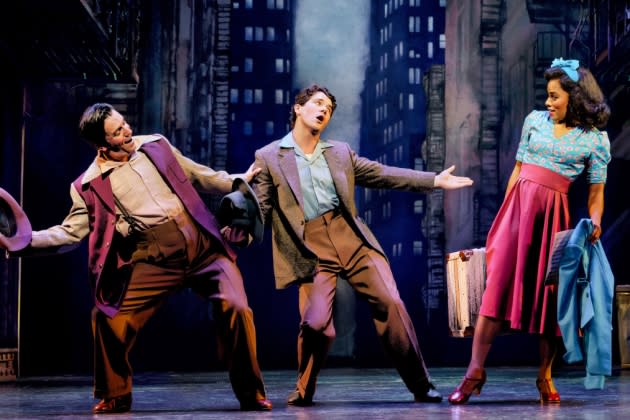‘New York, New York’ Review: New Kander and Ebb Musical Is a Love Letter to Big City Gusto

If there is a megawatt star in “New York, New York,” the new musical from Broadway titans John Kander and the late Fred Ebb (with additional lyrics by Lin-Manuel Miranda), it’s right there in the title. Aside from the occasional f-bomb and pantomimed scurry of rats, the show that opened at Broadway’s St. James Theatre is a love letter to Manhattan so unabashed that its vibe might be best expressed in cityscape and heart-eye emojis. Cynical? These New Yorkers? Fuhgeddaboudit!
Though inspired by the 1977 film directed by Martin Scorsese and starring Robert De Niro and Liza Minnelli, “New York, New York” is more accurately described as a musical-length rhapsody on the dreams crooned out in its title song, made famous by Frank Sinatra and naturally performed here as a big-band finale turned audience singalong. A crowded cast of characters has come to chase their dreams, and most of them want to be musicians.
More from Variety
Lin-Manuel Miranda on the Surprise Success of 'We Don't Talk About Bruno'
'Percy Jackson' Disney+ Series Casts Lin-Manuel Miranda as Hermes
Grammy Predictions: We Need to Talk About 'Encanto' as a Major Contender
The sensory splendors of director and choreographer Susan Stroman’s production — a tap line across an unfinished skyscraper, nighttime snowfall in Central Park, umbrellas blooming in a rainstorm — conjure boldly romantic and relatively timeless visions of the city. Set at the end of WWII and debuting at another time of tenuous renewal, “New York, New York” radiates an infectious optimism, as if hoping to deliver an antidote to a city and to an industry still in beleaguered recovery.
It has much of what Broadway lovers would want from such a musical, including songs by Kander and Ebb (some written for the film and others from their vault) plus half a dozen more written for the show by Kander in collaboration with Miranda. Jazzy, buoyant and infused at times with Afro-Cuban beats, the score makes a winning play for familiar pleasure centers and delivers a few memorable highlights, especially as its characters find musical success. Less distinctive and far lighter on verve than “Chicago” or “Cabaret,” the score reflects songwriters in a hopeful and affectionate mood.
The book by David Thompson, co-written with Sharon Washington, includes a diverse sprawl of urbanites beyond its leading lovers, a booze-soaked, flailing musician played by Colton Ryan (the film adaptation of “Dear Evan Hansen”) and a self-assured, aspiring Black singer played by Anna Uzele (“Six”). There’s also a Black trumpeter and veteran who laments the hypocrisy of post-war discrimination (John Clay III), a young violinist who escaped Europe and wants to attend Julliard (Oliver Prose), the teacher he begs to help him and whose son hasn’t yet returned from the war (Emily Skinner); and a Cuban mother and her queer, bongo-playing son (Janet Dacal and Angel Sigala) who live under the shadow of an abusive patriarch.
There are still others between scenes, including a maid who gets whisked onto the opera stage to deliver a full-throated aria during a dreams-really-do-come-true sequence in the second act. It’s a lot of striving to pack into a single show, and demands a similar sort of tolerance for too-muchness as New York itself does. But it’s all rendered with spectacular stagecraft, including Beowulf Boritt’s soaring and dynamic interplay of fire escapes, alleyways and iconic landmarks; evocative projections co-designed by Boritt and Christopher Ash; and lighting by Ken Billington that captures certain snapshots in the day that any New Yorker would say defy description.
That New York upstages any drama on stage in “New York, New York” may be inevitable to its inspiration and design; all of its characters simply want to make it here, though two of them also sometimes want love. Ryan’s bandleader is big-hearted, goofy and a bit sideways, like a wise-cracking Old Hollywood star, an accent he strangely affects when he sings with otherwise suave appeal. And Uzele’s star-on-the-rise is self-assured and tough, knowing she can’t afford to fumble opportunities the way her screw-up white lover does. The “Six” star fares less well as the role’s vocals call for greater sophistication, and chemistry between the pair can hardly be said to propel the story.
But the production’s zealous faith in New York — in its mythology of endless possibility and renewal — is near impossible to resist. Anyone who’s managed to carve out a place for themselves here, after being told they didn’t belong elsewhere, will likely feel a pang watching characters who are social outcasts and immigrants strive and achieve, despite being sketched in loose detail. Their triumphs, and the restless energy of the city, are vividly embodied in the dynamism of Stroman’s production, in the fluidity and grace of its agile choreography and the churn of its stage pictures and interludes.
And there’s a forward-looking nostalgia to “New York, New York” that feels alive to the peculiar and half-dazed mood outside its doors. New York has always run on a mix of blind faith bordering on delusion, and the people who flock here are full of it. Clichés, like stale bodega coffee, exist for a reason. They keep the city going even after it’s crashed and burned.
Best of Variety
Sign up for Variety’s Newsletter. For the latest news, follow us on Facebook, Twitter, and Instagram.

 Yahoo News
Yahoo News 